Go back twenty years and there were hardly any SUVs on the road. You might see the odd Wrangler here and there, and perhaps an old Toyota 4X4, but that was about it.
Fast forward to the present, and it’s all changed. SUVs have come to dominate, even surpassing saloon cars in popularity in many Western countries.
Even so, as a rule, most people are still new to them. While driving an SUV is similar to a conventional vehicle, not everyone goes in prepared.
Fortunately, we’re here to help. Here are some of the things you need to do if you’re new to SUVs:
Check Your Fuel Levels
SUVs are becoming more efficient, but they still guzzle gas faster than smaller vehicles. Hence, if you’re used to a convention ride, you might get a shock when you see the fuel gauge plummeting on a long journey.
Modern cars will warn you when they have less than 100 miles of range. However, if you are planning on taking your vehicle out into the country for some lonely miles, you’ll need to make sure that there are gas stations en route. Alternatively, take spare fuel with you.
Pay Attention To Your Tyres
SUVs tend to be quite hard on tyres, so you will need to go for a tyres service regularly to keep them legal. All the extra weight of the vehicle means that the rubber can wear out quickly, particularly if you do any hard braking.
Most SUV owners check their tyres for wear and tread depth once every three months or so. However, if you take your vehicle offroad, you’ll need to do it more often than this.
Pay Attention When Turning
SUVs are often taller and longer than standard cars which makes them more difficult to turn. If you’re going around a tight bend, pay attention to the inside rear wheel of the car. It won’t always follow the same path as the front.
Aim to drive in an arc. If you’re not used to this, practice doing it with your current ride.
Leave More Room For Braking
SUVs tend to be considerably heavier than standard cars. Therefore, you’ll also need to modify your braking to take this into account. Vehicles may weigh two or even three times as much.
Manufacturers accommodate this by beefing up the brakes, but this doesn’t always work. Even with discs all-round, you may still find that your stopping distance is 50 percent greater than it was before.
Get To Know The Vehicle
Because of changes in the shape of the chassis and the form factor, SUVs tend to be quite different from conventional vehicles. Therefore, you’ll want to spend some time getting to know your vehicle. Read the manual if you have to.
Avoid pushing the car beyond its limits. Most SUVs are made for families, not racing. Taxing the engine too much can result in frequent trips to the mechanic. Learn to use your SUV correctly. Remember, not all trucks and SUVs can handle bumpy off-road conditions.







